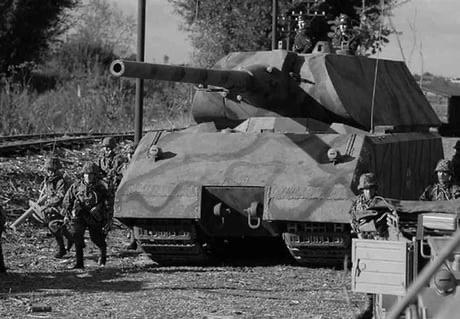I began my career in the military as a Mechanized Infantryman assigned to a unit with the M2A2 Bradley fighting vehicles. Because of this, our Task Force was mixed in with an Armor unit. So every Company in the Battalion had an Armor Platoon with the big beautiful M1A2 Abrams Tank. The massive and imposing Abrams makes me think of the dreaded German Panzer VIII Maus Tank of WWII.
The Panzer line underwent multiple upgrades until it finally got to version VIII. The line was designed by Porsche, which at the time was best known for the Volkswagon Bug. The Panzer early models were a little late in the game for WWII and eventually met their match at the Soviets’ T-34 tank.

Despite its Name, Maus Was Far From Small
In January 1943, Hitler intervened in the project and demanded that the tank have a 128mm main cannon, 75mm gun, and a machine cannon for air targets. But the original designs couldn’t support such a platform so a reworking was needed.
The German Panzer VIII Maus ended up being 10.2 m (33 ft) long, 3.71 m (12.2 ft) wide, and 3.63 m (11.9 ft) tall. It weighed 188 tons making it the heavier tank ever built! That’s 376,000 pounds of sheer terror. It featured a Mercedes Benz 500 series diesel motor that could create more than 1,200 horsepower.
Its main armament was the Krupp-designed 128 mm KwK 44 L/55 gun, based on the 128 mm Pak 44 anti-tank field artillery piece also used in the casemate-type Jagdtiger tank destroyer. Its 128 mm gun was powerful enough to destroy all Allied armored fighting vehicles of the time, some at ranges exceeding 3,500 meters (2,2 miles). Per Hitler’s demand, the engineers also installed a coaxial 75 mm KwK 44 L/36.5 gun.
The Panzer VIII also hosted 3,500 liters (924 gallons) of fuel; however, it could only go for approximately 100 miles before it needed to refuel. A six-man crew was needed to tame this beast of a machine.
Say what you will about the Nazi military, but it built some astonishing weaponry.
Panzer VIII Maus’s Ill-fated Future

The summer of 1944 changed the direction of the war entirely for Germany which was now retreating on all fronts. With the Allied invasion of Normandy and Operation Bagration, Allied forces began pushing the Nazis back to Germany.
A week after the failed assassination attempt against him on July 20, 1944, Hitler ordered work on the Panzer Maus to cease.
Nevertheless, testing still took place afterward. Yet, the Germans seemed unable to get the Maus to move more than 16-19 km per hour (nine-12mph). Continuous engine failures and the heavy Allied bombings against German factories made the project unsustainable. (Yet, it’s unlikely that the Allies knew precisely what the Nazis were building.)

It isn’t very likely that the tank ever saw action. It was so heavy that it required two Maus’s to pull one if it ever broke down. Many believe that the Germans themselves destroyed most of the Maus.
Had production started a few years earlier and some of the tank’s faults been resolved, it could have changed the landscape of the war. So, in the end, Panzer VIII Maus was the tank that never was.










COMMENTS
You must become a subscriber or login to view or post comments on this article.